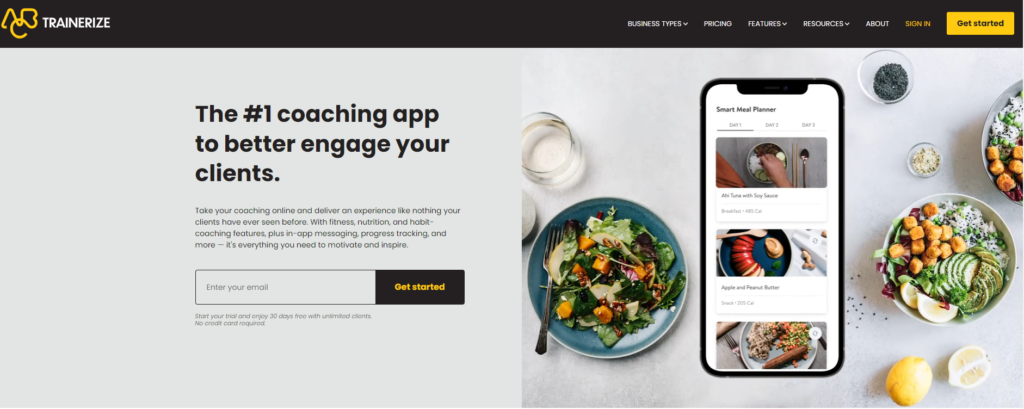
Welcome to a journey where passion meets profit!
In today’s digital age, the fitness industry is booming online, offering unprecedented opportunities for fitness enthusiasts to turn their expertise into a thriving business. Whether you’re a seasoned trainer or just starting out, this guide will equip you with the tools and strategies to build a successful online fitness coaching business.
From creating engaging content and leveraging social media to understanding the nuances of client management and monetization, we’ll cover it all. Get ready to inspire, motivate, and transform lives while building a business that not only sustains you but also fuels your passion for fitness.
Let’s dive in and start building your path to success!
TL;DR
- Craft a Killer Brand: Define your niche, create a strong online presence (website, social media), and build a brand that resonates with your ideal client. Use tools like Canva, Wix, or Squarespace.
- Master Marketing Magic: Attract clients through targeted social media marketing (Facebook Ads, Instagram Ads), content marketing (blog posts, ebooks), and strategic collaborations. Utilize tools like Later, Buffer, and Mailchimp.
- Deliver Exceptional Coaching: Provide personalized workout plans, nutritional guidance, and motivational support using platforms like Trainerize or TrueCoach. Focus on client communication and progress tracking.
- Monetize Your Expertise: Explore various pricing models (one-on-one, group coaching, packages), create digital products (ebooks, online courses), and offer premium services.
- Scale for Success: Systematize your processes, build a team (virtual assistants), and leverage technology to grow your business efficiently.
What is an Online Fitness Coaching Business?
An online fitness coaching business is a service-based enterprise where fitness professionals provide personalized fitness and wellness guidance to clients remotely, primarily through digital platforms. Unlike traditional gyms or in-person coaching, online fitness coaches leverage technology to deliver their services, connecting with clients via video conferencing, messaging apps, email, and fitness tracking apps. This allows for a geographically unrestricted client base and offers flexibility for both the coach and the client.
Key Aspects of an Online Fitness Coaching Business:
- Remote Delivery: The core characteristic is the remote delivery of services. This means no physical location is required, reducing overhead costs significantly.
- Personalized Programs: Successful online coaches create individualized workout plans and nutritional guidance tailored to each client’s specific needs, goals, and limitations. This personalized approach is crucial for client success and satisfaction.
- Technology Dependence: Reliance on technology is paramount. This includes using various software and apps for communication, program delivery, progress tracking, and client management.
- Digital Marketing: Effective online marketing is essential for attracting clients. This involves building a strong online presence, utilizing social media, content marketing, and potentially paid advertising.
- Client Communication: Maintaining consistent and effective communication with clients is critical. This often involves regular check-ins, progress monitoring, and providing support and motivation.
- Scalability: One of the significant advantages of an online business is its scalability. As the business grows, it’s relatively easier to add more clients without needing to expand physical space or hire a large in-person team.
- Diverse Service Offerings: Online fitness coaching can encompass a wide range of services, including personalized workout plans, nutrition coaching, online group fitness classes, educational resources (e.g., ebooks, online courses), and motivational support.
Understanding these key aspects is crucial for anyone looking to establish and successfully run a profitable online fitness coaching business. The flexibility and scalability offered by this model provide a compelling alternative to traditional fitness coaching, opening doors to a wider audience and greater earning potential.
Defining Your Niche and Building Your Brand
Before you start marketing, identify your niche. What type of fitness coaching will you offer? Weight loss? Strength training? Yoga? Specializing allows targeted marketing. Once you have your niche, build your brand. This involves creating a logo (Canva or Adobe Illustrator), a professional website (Wix, Squarespace, WordPress), and engaging social media profiles (Instagram, Facebook, TikTok). For example, a coach specializing in “postpartum fitness” would use imagery and language that resonates with new mothers. Their website should highlight their understanding of the unique physical and emotional challenges of this population.
Creating a Compelling Online Presence
Your website is your digital storefront. It needs to be professional, user-friendly, and showcase your expertise. Include testimonials, client success stories, and a clear call to action (“Book a Free Consultation”). Your social media presence is equally crucial. Use platforms like Instagram, Facebook, and TikTok to share valuable content, engage with your audience, and build a community. Consistency is key—aim for regular posts and interaction. Tools like Later can help schedule posts across multiple platforms.
Marketing Your Online Fitness Coaching Business
Marketing is key to attracting clients. Consider these strategies:
- Social Media Marketing: Use targeted advertising (Facebook Ads, Instagram Ads) to reach your ideal clients. Create engaging content—short workout videos (InShot for editing), healthy recipes, motivational posts. Use relevant hashtags to increase visibility.
- Collaborations: Partner with other fitness professionals, influencers (Upfluence can help find relevant influencers), or businesses (local health food stores) to expand your reach.
- Email Marketing: Build an email list (Mailchimp, ConvertKit) and send regular newsletters to keep subscribers informed. Segment your list for targeted messaging.
Content Marketing
Content marketing is crucial for attracting and engaging potential clients. Creating valuable, informative content positions you as an expert in your niche and builds trust with your audience. This could include blog posts, articles, ebooks, infographics, and even videos. Think about the questions your ideal clients are asking, and create content that answers those questions. For example, if you specialize in weight loss, you might create content on topics like “The Best Foods for Weight Loss,” “How to Create a Calorie Deficit,” or “Effective Workout Routines for Weight Loss.”
Consider creating similar educational videos on topics relevant to your niche. For instance, a video explaining the benefits of protein over sugar, like this one, Eat More Protein (Because Sugar Is Poison?) can attract a health-conscious audience and establish your expertise in nutrition. Remember to keep your videos concise, engaging, and visually appealing. Use clear and simple language, and focus on providing practical information that your audience can use. Promote your videos on your social media channels and embed them on your website.
For More Free Videos, Subscribe to the Rhodes Brothers YouTube Channel.
Utilizing Tools for Success
Several tools can streamline your business:
- Scheduling Software: Acuity Scheduling or Calendly for clients to book appointments directly.
- Client Management Software: Trainerize or TrueCoach to manage clients, track progress, and deliver personalized plans.
- Email Marketing Platforms: Mailchimp or ConvertKit for managing your email list and automated email sequences.
- Social Media Management Tools: Buffer or Hootsuite to schedule and manage social media posts.
- Fitness Tracking Apps: Integrate with apps like MyFitnessPal or Fitbit to track client progress and provide data-driven feedback.
Delivering Exceptional Coaching
Providing exceptional coaching is crucial for client retention and referrals. Build strong relationships, understand individual needs, and provide personalized support:
- Personalized Workout Plans: Create customized plans using Trainerize or Google Sheets. A plan might include cardio, strength training, and flexibility exercises, tailored to the client’s fitness level and goals.

- Nutritional Guidance: Offer guidance using resources like the USDA’s MyPlate or apps like Cronometer.
- Motivational Support: Use your chosen client management system’s communication tools for regular encouragement and accountability.
Monetizing Your Online Fitness Coaching Business
There are several ways to monetize:
- Pricing Models: Offer various pricing packages based on the level of support and services. One-on-one coaching, group coaching, or packages combining both.
- Digital Products: Create and sell ebooks, workout guides, meal plans, or online courses.
- Premium Services: Offer personalized nutrition plans, advanced training programs, or one-on-one consultations.
- Affiliate Marketing: Promote relevant products or services and earn a commission.
Scaling Your Online Fitness Coaching Business
As your business grows, systematize your processes and build a team:
- Streamlining Operations: Develop efficient systems for managing clients, delivering coaching, and handling administrative tasks.
- Building a Team: Hire virtual assistants to help with marketing, client communication, and administrative support.
- Leveraging Technology: Use technology to automate tasks, track progress, and improve efficiency.
Actionable Steps and Direct Advice for Online Fitness Coaching Business
For Beginners
Starting your online fitness coaching business can feel overwhelming, but breaking it down into manageable steps makes it achievable. Begin by identifying a niche you’re passionate about. This passion will fuel your commitment and help you create engaging content. Don’t try to be everything to everyone; focus on a specific area where your expertise shines. For example, instead of “general fitness,” consider “yoga for beginners” or “strength training for seniors.”
Next, build a basic website and social media presence. You don’t need a fancy website initially; a simple site with your services, pricing, and contact information will suffice. Platforms like Wix or Squarespace offer easy-to-use website builders. Focus on one or two social media platforms where your target audience is most active. Instagram is visually driven and ideal for showcasing workouts and healthy recipes, while Facebook allows for more detailed posts and community building.
Finally, offer a free introductory session or consultation to attract your first clients. This allows potential clients to experience your coaching style and build trust. Word-of-mouth referrals are powerful, so provide exceptional service to your initial clients. Consider offering a discounted rate for your first few clients to build your portfolio and gather testimonials.
For Millennials
Millennials are digitally native and highly engaged on social media. Leverage this to your advantage. Create engaging content that resonates with their values and lifestyle. Short, visually appealing videos, interactive polls, and stories are highly effective. Use relevant hashtags to increase visibility and participate in relevant online fitness communities.
Effective social media marketing is crucial. Use targeted advertising on platforms like Instagram and Facebook to reach your ideal clients. Analyze your ad performance and adjust your strategy accordingly. Consider collaborating with fitness influencers who align with your brand and target audience. This can significantly expand your reach and introduce you to a new audience. Remember to track your results and measure the return on investment (ROI) of your influencer marketing campaigns.
For People Nearing Retirement
Building a sustainable online fitness coaching business that allows for flexibility and work-life balance is key for those nearing retirement. Focus on creating a business model that fits your lifestyle and energy levels. This might involve offering smaller group coaching sessions or one-on-one coaching with a limited number of clients.
Offer specialized programs tailored to older adults, focusing on areas like flexibility, balance, and strength training for injury prevention. Highlight the benefits of exercise for maintaining independence and improving quality of life in your marketing materials. Emphasize the personalized attention and support you provide, catering to the specific needs and limitations of your older clients. Consider offering flexible scheduling options to accommodate different time zones and preferences. Building a strong reputation for reliability and personalized care will be crucial for attracting and retaining clients in this demographic.
Common Mistakes to Avoid for Online Fitness Coaching Business
Not Defining Your Niche
- Mistake: Trying to appeal to everyone results in a diluted brand and ineffective marketing. You lack a clear target audience and struggle to stand out from the competition.
- Solution: Conduct thorough market research to identify a specific niche where you have expertise and passion. Consider factors like age, fitness level, specific goals (weight loss, strength building, etc.), and lifestyle. Focus your marketing efforts on this specific group. For example, instead of targeting “all women,” focus on “postpartum women seeking to regain strength and fitness.” This allows for more targeted marketing and content creation.
Poor Marketing
- Mistake: Underestimating the importance of marketing leads to low client acquisition. Relying solely on word-of-mouth is insufficient for sustainable growth.
- Solution: Develop a comprehensive marketing strategy encompassing various channels. This includes social media marketing (creating engaging content, running targeted ads), content marketing (blog posts, ebooks, free resources), email marketing (building an email list and sending regular newsletters), and potentially collaborating with other fitness professionals or influencers. Track your marketing efforts to measure their effectiveness and adjust your strategy accordingly. Don’t be afraid to experiment with different approaches.
Lack of Client Communication
- Mistake: Inconsistent or poor communication leads to client dissatisfaction and churn. Clients feel neglected and unsupported, impacting their motivation and results.
- Solution: Establish clear communication protocols. This involves regular check-ins (weekly or bi-weekly), prompt responses to client inquiries, and personalized feedback on their progress. Use a client management system to track communication and ensure nothing slips through the cracks. Consider using different communication channels (email, messaging apps, video calls) to cater to individual client preferences. Proactive communication—sending motivational messages or sharing relevant resources—can strengthen client relationships.
Ignoring Client Feedback
- Mistake: Failing to solicit and act upon client feedback prevents improvement and limits growth. You miss opportunities to enhance your services and address potential issues.
- Solution: Regularly solicit feedback from your clients through surveys, questionnaires, or informal check-ins. Create a safe space for clients to share both positive and negative feedback. Actively listen to their concerns and suggestions. Analyze the feedback to identify areas for improvement in your coaching style, program design, or communication. Implement changes based on this feedback and communicate these changes to your clients, demonstrating your commitment to their success.
By proactively addressing these common mistakes and implementing the suggested solutions, you can significantly increase your chances of building a thriving and sustainable online fitness coaching business. Remember that continuous learning and adaptation are key to long-term success.
Frequently Asked Questions
How do I get started with online fitness coaching?
Start by defining your niche, building a website, and creating a social media presence. Offer a free introductory session to attract your first clients.
What’s the best way to attract clients?
Utilize a combination of social media marketing, content marketing, and strategic collaborations.
How much can I earn as an online fitness coach?
Your earnings will depend on your pricing model, the number of clients you have, and the services you offer.
What are the essential tools for online fitness coaching?
Scheduling software, client management software, email marketing platforms, and social media management tools.
How do I create effective workout plans?
Consider your client’s fitness level, goals, and preferences. Ensure plans are safe and effective.
How do I handle client communication effectively?
Regular check-ins, prompt responses, and personalized feedback are key.
How do I stay motivated and avoid burnout?
Prioritize self-care, set realistic goals, and celebrate your successes.
How do I deal with challenging clients?
Establish clear boundaries, communicate effectively, and seek support if needed.
How do I scale my online fitness coaching business?
Systematize your processes, build a team, and leverage technology.
What legal considerations should I be aware of?
Consult with a legal professional to ensure you comply with all relevant regulations.
Reap the Rewards of Your Fitness Passion
Building a profitable online fitness coaching business is a journey that blends your passion for fitness with entrepreneurial spirit. By defining your niche, crafting a strong brand, mastering effective marketing strategies, delivering exceptional coaching, and continuously adapting to the evolving digital landscape, you can achieve significant success. Remember the actionable steps we’ve discussed: from creating personalized workout plans and providing motivational support to leveraging social media and building a strong online presence. Avoid common pitfalls like neglecting client communication or ignoring valuable feedback.
This isn’t just about building a business; it’s about empowering others to achieve their health and fitness goals. The impact you have on your clients’ lives will be incredibly rewarding. The financial rewards will follow as you build a reputation for excellence and expand your reach.
Take the first step today. Identify your niche, create a basic website, and start connecting with potential clients. Don’t be afraid to experiment, learn from your mistakes, and adapt your strategies as you grow.
Thank you for joining us on this journey. We encourage you to check out the Rhodes Brothers YouTube Channel for the latest videos and information to help you succeed in building your online fitness coaching business. We’re here to support you every step of the way!
Resource List
Books
- The Lean Startup by Eric Ries (for understanding business model development)
- Building a StoryBrand by Donald Miller (for crafting compelling brand messaging)
- Permission Marketing by Seth Godin (for understanding effective marketing strategies)
- Influence: The Psychology of Persuasion by Robert Cialdini (for understanding persuasion techniques in marketing and client communication)
- Atomic Habits by James Clear (for building consistent habits for business growth)
Courses & Podcasts
- Skillshare: Offers various courses on marketing, branding, and social media management.
- Udemy: Provides a wide range of fitness-related courses and business courses.
- Pat Flynn’s Smart Passive Income Podcast: Focuses on building online businesses.
- The Tim Ferriss Show: Features interviews with successful entrepreneurs and experts in various fields.
- Entrepreneurs on Fire: Another popular podcast with interviews of successful entrepreneurs.
Tools & Software
- Canva: For graphic design and creating marketing materials.
- Wix/Squarespace/WordPress: For building a website.
- Mailchimp/ConvertKit: For email marketing.
- Acuity Scheduling/Calendly: For scheduling appointments.
- Trainerize/TrueCoach: For client management and program delivery.
- Buffer/Hootsuite: For social media management.
- Google Analytics: For tracking website traffic and user behavior.
- SEMrush/Ahrefs: For keyword research and SEO analysis.
Online Fitness Coaching Business Cheat Sheet
- Define your niche
- Build a strong brand
- Create a professional website
- Utilize social media marketing
- Develop engaging content
- Offer personalized coaching
- Provide excellent client communication
- Implement effective marketing strategies
- Explore various monetization options
- Systematize your processes
- Scale your business strategically
- Track your progress and adapt accordingly
- Seek continuous learning and improvement
- Use scheduling software (Acuity, Calendly)
- Use client management software (Trainerize, TrueCoach)
- Use email marketing platforms (Mailchimp, ConvertKit)
- Use social media management tools (Buffer, Hootsuite)
- Create personalized workout plans
- Offer nutritional guidance
- Provide motivational support
- Regularly solicit client feedback
- Invest in marketing and advertising
- Build strong client relationships
- Offer various pricing packages
- Create and sell digital products
- Collaborate with other professionals
- Hire virtual assistants as needed
- Leverage technology for efficiency
- Focus on a specific target audience
- Track your marketing ROI
- Prioritize client communication
- Continuously improve your services
- Maintain a work-life balance (especially for those nearing retirement)
- Use Canva for design
- Use WordPress, Wix, or Squarespace for website building
- Use Google Analytics for website tracking
- Use SEMrush or Ahrefs for SEO analysis






